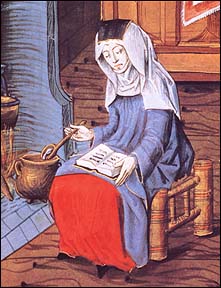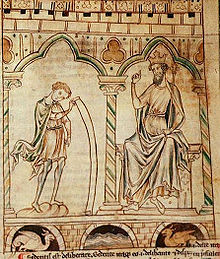'Writing Medieval History' is a collection of essays aiming to survey how theories developed from the 'linguistic turn' and Postmodernism have and can be used in Medieval studies. It does this by concentrating on three key themes: the self, the use of literary techniques in history and sex and gender. This approach is useful by allowing in-depth accounts of particular 'new' methods, but does this at the expense at of having less breadth.
The range of authors employed in the 9 essays allows some differentiation in the way each chapter is approached and structured. But they all fundamentally are made up of two key parts, the theory and an example of how this can be applied practically. This is helpful as it allows the reader to identify instances where they could similarly apply the techniques offered. Each chapter concludes with detailed footnotes and a guide to further reading. The latter is useful in guiding the reader to broader works in the humanities and social sciences, while at the same time pointing towards further Medieval studies using postmodern methods.
The first section of 'Writing Medieval History' is entitled 'Recognizing People in Medieval Society: The Self'. As implied by the title, the chapters here focus on the interaction between the 'self' and wider society and forms through which the 'self' is represented. 'Social Selves in Medieval England: The Worshipful Ferrour and Kempe' by David Shaw looks at social networks in the towns of Wells and Lynn and how individuals interactions with these shaped their identity. Richard Ferrour and John Kempe (wife of the the mystic Margery Kempe) were shaped not only by the wider assumptions of society, such as gender and urbanity, but also were affected by the cultural impact unique to their communities. Shaw suggests this was based on characteristics such as honour and fidelity and their pursuit of an identity was based on achieving status through these means. The chapter is useful in showing how documentary evidence can be used to not only show social networks, but how these relate to the individuals interaction with society.
'Biography and Autobiography in the Middle Ages' by Jay Rubenstein by looking at these literary genres suggests that the often cited 'discovery of the individual' was did not spontaneously occur in the 12th century. Instead, what occurred was that writers in the late 11th century began to formulate new ideas about the 'self', therefore instead of a 'discovery' of the individual there were developments and in how to think and write about it. Rubenstein also suggests that elements of Medieval autobiography can be detected in biographical works- which often contain details relating the author to the subject of the text. Medieval biographies also come with an agenda or theoretical apparatus that differ from the modern versions of these genres, for example Vitae may offer a model for how life ought to be led.
The final chapter in the section about the 'self' is 'The Hidden Self: Psychoanalysis and the Textual Unconscious'. Focusing on the use of the basic Freudian principles for psychoanalysis it also dips into the works of some later writers, such as Marshall Edelson, but at the same time lacks space to go into the works of other important psychoanalysts, such as Jacques Lacan. By taking into account how the mind symbolises what lays beneath its surface, Nancy Partner looks at accounts of Medieval dreams and looks for hidden meanings. She concludes that psychoanalytic theory can be used to show individuals 'pushing back' against a conformity-demanding culture and that it respects the individual psyche's fundamental activity of informing the world with meaning.
Margery Kempe
The second section 'Literary Techniques for Reading Historical Texts' begins with a chapter by Robert M.Stein on 'Literary Criticism and the Evidence for History'. Stein uses 'deconstructive' methods (in the weak sense, not directly related to the works of Derrida) to understand the operations that construct a text as a meaningful object. Written evidence should not be solely mined for clear facts and should not be just understood on the surface. The way in which text is composed can reveal further meaning. Using the example of the Hyde Chronicle, Stein shows how syntax and tense ere employed to show specific narratives. The Hyde Chronicle (detailing the Norman Conquest) changes form with the transition from Harold to William. William's accession to the throne is wrote as passive, maintaining Harold's legitimacy to the last moment while placing importance on divine intervention on the outcome of the change in Kingship.
Sarah Foot in 'Finding the Meaning of Form: Narrative in Annals and Chronicles' continues the section on literary techniques. Annals and chronicles are not simply chronological recordings of events they convey specific narratives and often wrote with purpose. The Royal Frankish Annals focuses on the Franks as a people and the idea they have a shared destiny with the Carolingians. Notable omissions include the Merovingian era, the history starts with Charles Martel. The annals are also intentionally tied around the liturgical calendar, placing the Frankish people and their Kings into a linear and Christian notion of time. The Anglo-Saxon Chronicle is used as another example, composed with the purpose of promoting the idea of Angelcynn in line with Alfred's political ideals in his conflict with the Vikings. Chronicles and annals must not be taken at face value.
'Functions of Fiction in Historical Writing' looks at how Medieval genres including fiction and non-fiction were more permeable. Fantastical elements can appear in texts which may otherwise appear to be more historical for the modern reade. The works of Geoffrey of Monmouth and William of Newburgh are used to show 'creative history-making' with a purpose. This can be seen when William uses Gerbert of Aurrilac and an Aqutainian monk's experience in an 'underground frozen world' with 'automata' as metaphor for the the past not being fully retrievable. Gerbert and the monk cannot touch anything in the underground realm as it would result in their deaths, despite the former's 'magic'. The 'magic' symbolic for the historian's interaction with the past. Fictionality was not simply accepted as fact, it was a means of conveying specific narratives. Geoffrey of Monmouth was criticised for being a 'liar', but at the same time the way he uses fictionality (i.e Brutus being the legendary founder of Britannia) was adopted in later histories for use in ancestral claims. Therefore, in this essay, Monika Otter shows that fiction and non-fiction were mixed and combined in some Medieval writings.
Merlin and Vortigern from Monmouth's 'History of the Kings of Britain'
The third part is called 'Historicising Sex and Gender'. The first chapter 'Historicising Sex, Sexualising History' takes into account that despite the human body being biologically similar, it does not mean that the Medieval period understood it in the same way. Firstly, medical knowledge at the time shaped the way in which it was understood. However, cultural regulation occurs through laws and taboos. Sexuality in Medieval Europe was heavily restricted by canon law. For example, the 'conjugal debt' expressed spouse's sexual commitment to each other, but as always it is always difficult to identify how far canon law was followed. In the instance of conjugal debt, the husband and wife both technically had equal status, yet at the same time it would appear this often did not happen in practice. Jacqueline Murray's chapter therefore explores how biolgogical and cultural understandings influenced the Medieval notion of 'sex'.
Cordelia Beattie's chapter on 'Gender and Femininity in Medieval England' using the theory of Judith Butler shows how gender in the Medieval Period could be performative and not simply related to the wider assumptions of society. Some actions were 'feminine' while others were 'masculine' and yet at the same there were multiple 'feminities'. The 'Good Wife' archetype was chaste, modest and obedient to her husband, whereas the archetype of the 'Evil Wife' had characteristics such as extravagance and gossiping. Beattie's point is that there were multiple ways in the Medieval Period for woman to be seen acting as feminine, regardless if these different forms were valued on the same 'moral' level. The example of Margery Kempe is used to show how the idea of a woman being in control of the household economy, was yet another discourse in competition for the idea of 'femininity'.
The final chapter of the book 'Masculine Identity in Late Medieval English Society and Culture' by Derek Neal looks at some of forms through which Medieval masculinity was expressed. One of these is language and how it relates to the competitive nature of masculinity in the era. 'Boy' did not refer to a 'Male Child' before the 15th century, instead referring to 'servant' or 'person in a menial position'. When applied it was a derogatory term meant to undermine someone's masculinity, showing how gender could be related to hierarchies of power. Masculinity could be measured by how one used property- misabuse and greediness could be aligned with a lack of masculinity, once again showing a range of masculinities in discourse. Neal also focuses on how masculinity was realigned with the clerical and therefore celibate world. Expressions of sexuality, especially with a lack of self-control, could demasculinise and could take away from a man's reputation in gendered hierarchies. The chapter therefore adds to the debate on nor only the construction of masculinity in the Medieval Period, but how different ideas about it fought each other.
To summarise, 'Writing Medieval History' is mostly successful in providing an insight into some of the methods associated with Postmodernism and how the Medievalist can apply these. The focus on three key themes allows the text to go in-depth on specific theories, while avoding other potential areas of focus, such as Medieval postcolonialism, queer theory and cultural studies. As a result of this, each section is more than a simple snapshot of a particular method than may have appeared in a more general book on Medieval writing or Postmodern techniques, allowing the reader to gain more valuable in-sight and placing them in a better condition to carry out further reading or apply theory. Therefore, while not comprehensive, 'Writing Medieval History' is an accessible and well-written introduction to the use of Postmodern techniques in the Medieval discipline.
Image credit goes to:
Wikicommons
http://www.luminarium.org/medlit/margery.htm



No comments:
Post a Comment